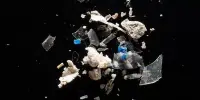Man-made chemicals used to enhance plastics – fillets are found everywhere from plastic packaging to household cleaners and cosmetics. According to a new survey, you can also find them in the newly laid eggs of seagulls. Scientists at the University of Exeter and the University of Queensland recently collected eggs from 13 European herring roses collected from a site on Cornwall on the south coast of the United Kingdom. Each has six different types of phthalates.
In their research reports in the Journal of Marine Pollution Bulletin, the researchers further stated that they may have been involved in oxidative stress in the presence of phthalates and increased the true likelihood that these pollutants could cause problems for their health. However, more research is needed to gain insight into whether this is harming the chicks growing inside the egg. Professor Jon Blount, study author from the Centre for Ecology and Conservation at the University of Exeter, said in a statement, “Research on the effects of plastics on animals has largely focused on the incorporation and incorporation of plastic fragments. Little is known about the effects of plastic additives on the body.”
“By testing the eggs, our study gives us a snapshot of our mother’s health – and this may be associated with increased oxidative stress from footlet contamination and mothers pass this expense on to their offspring through eggs,” he explained. “Our research proves that mothers inadvertently spend more on flatlet and lipid loss products – and eggs with higher phthalate contamination contain more lipid loss and vitamin E.”
Flatlets are a large group used to increase their flexibility, clarity, durability and longevity in the processing of plastics. According to the U.S. Centers for Disease Control and Prevention, you can also expect a lot of different types of urine in most people’s urine.
The specific health effects of phthalates have been obscured in the past, but growing evidence is beginning to suggest that they may have a profound effect on animal health. One of the major concerns stems from the ability to disrupt the endocrine system, the collection of glands that produce hormones to control metabolism, sexual function, reproduction, sleep, mood, etc. Dr. Shanna H. Swan, a leading environmental and reproductive epidemiologist at the Ikahan School of Medicine in Mount Sinai, recently published a book Countdown on the Environmental Pollution Effects on Her Fertility, predicting that the perpetual presence of flatlets could bring some huge amount Short genitals.
















